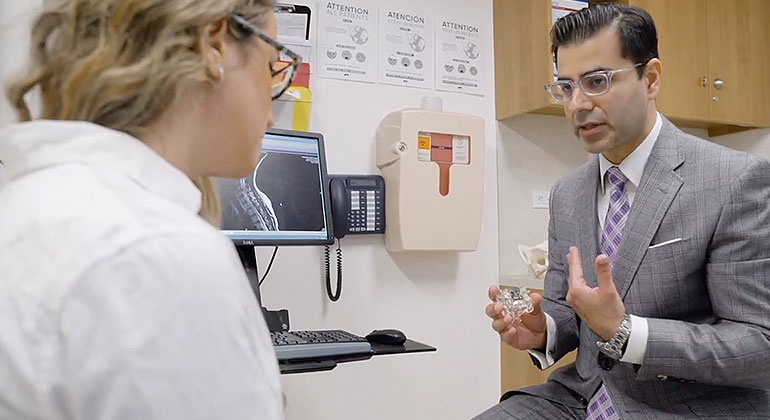Minimally Invasive Spine Surgery and Motion Preservation


Whenever possible, our surgeons perform minimally invasive and motion-preserving surgery, which enable patients to get back to their active lifestyle as quickly as possible. With minimally invasive surgery, we use smaller incisions. These reduce disruption to the spine and cause less damage to the surrounding soft tissue, less muscle tearing, and less blood loss. As a patient, you will experience less pain and quicker recovery time, and range of motion is preserved.
We use many minimally invasive technologies, which are alternative treatments from the traditional, more invasive methods, such as spinal fusions. Such techniques include cervical laminoplasty, and cervical disc replacement. They preserve range of motion in the cervical spine and take pressure off the nerves, which leads to faster recovery and fewer issues in the future. Even when a patient needs a spinal fusion, we can use minimally invasive techniques along with the fusion procedure to expedite your treatment and recovery process. Rather than cut the muscles, we simply spread them out of the way and insert a small tube with cameras and specialized tools on the end. We use robots and computer navigation when necessary to help us see what is going on inside your body.
Conditions We Treat
We use minimally invasive spine surgery for a broad range of procedures, and the number of conditions that we can treat in this way continues to grow. Conditions include the following:
- Compression fractures occur most often in the thoracic and lumbar spines of older patients with osteoporosis. Compression fractures can cause acute back pain that gets worse when you stand.
- Degenerative/arthritic disc disease and back pain, also known as “wear-and-tear” changes in the bones, ligaments, and discs of the spine, can lead to pain, weakness, or numbness.
- Herniated discs usually affect the cervical, thoracic, or lumbar spine. They stem from trauma or wear-and-tear changes. When you have a herniated disc, part of the disc bulges out of place and may put pressure on the spinal cord or nerve roots. This can lead to back/leg or neck/arm pain, weakness, or numbness.
- Scoliosis is an abnormal curvature of the spine that can cause pain, decreased mobility, and heart and lung problems. Depending on the degree of curvature, we may need to perform surgery to realign your spine to improve your appearance and treat pain, weakness, or shortness of breath.
- Spinal infections/osteomyelitis occur located in the vertebrae (bones), discs, or surrounding muscles of the spine. While we can often treat them with antibiotics, sometimes we need to do surgery to get rid of the infection.
- Spinal instability and spondylolisthesis happen when one vertebra “slips” in front of another, which can cause severe back and leg pain.
- Spinal stenosis is often an arthritic narrowing of the spinal canal that typically affects the cervical lumbar spine. This common problem can lead to pain in the arms and legs.
- Spinal trauma can cause damage to bone, ligaments, and muscles, and can destabilize your spine and spinal cord. We may need to do surgery to stabilize the spine and prevent further injury.
- Spinal tumors can be malignant (cancerous) or benign (noncancerous). Even if there is no cancer, we often remove tumors because they can cause structural instability in the spine, leading to fractures. Spinal tumors can also put direct pressure on the spinal cord and nerve roots, causing pain, weakness, or numbness.
Advances in Care
The Mount Sinai Health System is leading the way in using small cameras (endoscopes), tube-shaped retraction systems, robots, and intraoperative computer-assisted navigation in minimally invasive spine surgery. We offer a variety of these procedures including:
- Minimally invasive foraminotomy, laminectomy, and diskectomy enable us to treat nerve from the affected area. We can free the nerve from the compressing disc, bone, or ligaments. Often, you can go home the day of surgery with significant symptom relief.
- Cervical laminoplasty is a motion-preserving operation to take the pressure of the nerves while maintaining your range of motion. We are one of the leading centers in the United States for this procedure.
- Cervical disc replacement is an additional motion-preserving procedure for patients with disc herniations in their cervical spine. This represents an alternative to a traditional spinal fusion.
- Thorascopic surgery involves placing a miniature camera through a small tube in your body to view the spine and affected nerves. This helps us remove the herniated disc with minimal disruption to spinal stability and without having to perform spinal fusion. This means we do not need to make a long incision in your back to place the screws and rods.
- Laparoscopic and direct lateral (DLIF, XLIF) lumbar surgery is an innovative approach for patients who require a lumbar fusion. Our neurosurgeons access your spine through a small incision in your side, then spread the surrounding structures through a series of dilators. This approach allows access to the front of your spine (the anterior spine) with less risk than traditional open anterior surgery.
- Minimally invasive fusion and percutaneous pedicle screw fixation uses advanced imaging technology to guide the surgical instruments through a small, tube-shaped retractor.
- Vertebroplasty and kyphoplasty require only small incisions. We expand your compressed bone using a type of bone cement that corrects bone height and deformity.